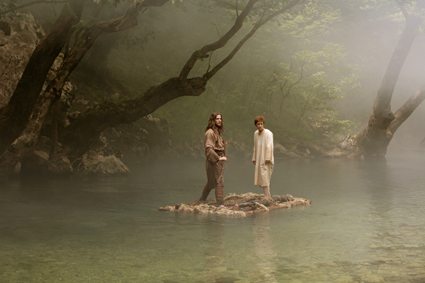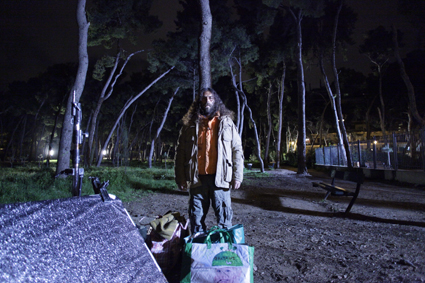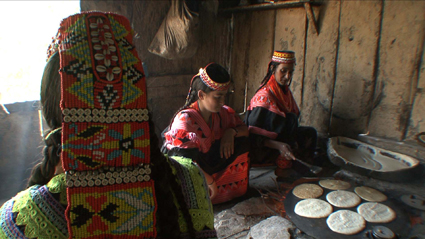shades of light and dark
katerina sakkas: 2011 greek film festival

Black Field
A NEW WAVE OF FILMMAKERS AT THIS YEAR’S GREEK FILM FESTIVAL TACKLED SUBJECTS THAT WERE OFTEN AT ODDS WITH TRADITIONAL GREEK CULTURE. THEIR WORKS DISPLAYED CHARACTERISTICS OF REMODERNISM, THE MOVEMENT DEVELOPED BY US PAINTER AND FILMMAKER JESSE RICHARDS IN 2000 WHICH ADVOCATES A MORE CONTEMPLATIVE STYLE OF CINEMA, AVOIDING CONVENTIONAL NARRATIVE STRUCTURE.
Three directors at this year’s festival—Vardis Marinakis, Yannis Economides and Athina Rachel Tsangari—allow events to unfold slowly through an accumulation of quiet moments, making a feature of repetition and dwelling in long takes on their characters’ physical environments. This contributes to a sense of frustration and mundanity in films like Economides’ Knifer and Tsangari’s Attenberg and of transcendent beauty in Marinakis’ Black Field. Two films discussed in this article engage with ancient cultures and emerge full of hope, while the others are studies in modern dislocation and emptiness, their depiction of Greek society less than cheering. Whether dark or light, however, it was heartening to see evidence of thought-provoking, sophisticated contemporary Greek film, despite the country’s current financial woes.
black field
Most distinctive in Marinakis’ Black Field is its creation of an immersive atmosphere that is simultaneously ancient and timeless, something perhaps more attainable in Greece with its still pervasive sense of the Byzantine, the medieval. Set in 1654, during Greece’s long period under the Ottoman Empire, it opens in a mountain monastery where a pious young nun, Anthi, leads a life of spartan ritual. One day a wounded rider collapses outside and is taken captive by the nuns; he is a janissary—one of the many Greek men taken as children to become soldiers in the Ottoman army and converted to Islam.
Anthi finds herself becoming attached to the soldier, something further complicated by the fact that she is really a boy, hidden since infancy among the nuns in order to avoid meeting the same fate as the janissary. As her religious obedience begins to be challenged by growing sexual tension, Anthi’s inner conflict unfolds through seamlessly edited lyrical imagery. Rendered in a palette of greys, the monastery through which the black-shrouded figures move has a stony monumentality that mimics its mountainous surroundings. In her bare cell Anthi lies like a sculpture or, in one of the film’s sudden moments of violence, slashes her inner thigh with a jagged piece of glass in mortification of the flesh. Restrained in his own cell, illuminated by a flickering lantern, the injured janissary is depicted in the manner of a Baroque painting of the dead Christ.
In verdant contrast, the forest to which the pair eventually escape is a glowing prelapsarian world—a place of absolute freedom. The whole film is suffused with an almost visionary quality: an otherworldly sense of the sacred, not limited to a Christian interpretation of the word, conveyed through long, contemplative takes, a paucity of dialogue and an emphasis on the elemental. While its homoerotic theme is to a degree subversive in this religious context, it’s undercut by the fact that a female actor (the remarkable Sophia Georgovassili) plays Anthi, thus rendering the prolonged final sex scene less challenging to conservative audiences, though this departure from realism by no means deprives the film of its power.
knifer

Knifer
“I see Athens as my personal hell,” says Knifer director and co-writer Yannis Economides in an interview on the film’s website (www.knifer.gr). “The reality we are experiencing has not yet been expressed through a contemporary perspective. We are holding onto readymade mythologies. I want to talk about the society in which I live, the people I know, a society in decadence heading towards a dead end.” The result is Knifer, a drawn-out excursion into the banal seaminess of some lives. The film’s central character, Nikos (Stathis Stamoulakatos), is a fat 30-ish good-for-nothing who agrees to move from northern Greece to Athens in order to watch over his crass uncle’s guard dogs. Economides forces the viewer to participate in his protagonist’s bored isolation, introducing scene after lengthy scene of Nikos indulging in unpleasant personal habits, or sitting alone in a range of bars and cafes surrounded by others’ trivial conversation.
Scenes of mundanity are dwelt upon, while the film’s most violent moment passes by quickly; immediately after a murder occurs, the camera lingers in a single excruciating take on Nikos in his hotel room, munching his expressionless way through an entire packet of potato chips. Sex in Knifer is mechanistic and awkward with an edge of the grotesque, a characteristic shared by Athina Rachel Tsangari’s Attenberg, another festival film with emptiness at its heart (albeit with a more appealing protagonist). Stylishly shot in black and white, Knifer drives home its point unambiguously and often searingly, but occasionally risks exhausting its audience’s patience.
the nymphs of hindu kush

The Nymphs of Hindu Kush
In a different category from Black Field and Knifer, Anneta Papathenasiou’s The Nymphs of Hindu Kush is a documentary focusing on the mountain-dwelling Kalasha tribe of north-west Pakistan. This agrarian community of 4,000 people, who some believe are the descendents of Alexander the Great (though there is no concrete evidence) have maintained their ancient customs and polytheistic religion surrounded by a population of 165 million Muslims. The documentary is wide-ranging, giving an overview of Kalasha life through many interviews and rare footage of ceremonial occasions, but Papathanasiou’s real focus is on the Kalasha women, who seem to enjoy a degree of autonomy greater than that afforded their Muslim countrywomen. Even so, they are constrained by traditional expectations that they will devote their lives to toiling long hours in the fields as well as tending to family at home.
It’s therefore startling to discover the younger generation of Kalasha women are undergoing a sudden transformation: while still strongly attached to their culture, they nurse ambitions for careers in social work, medicine and teaching. This radical shift is to a significant degree the doing of the Greek Volunteers, a Greek NGO that started working to improve health and education in the region, as well as to preserve Kalasha culture, in 1995. As well as building a new school to replace the previous substandard building, the group provided educational scholarships for Kalasha children otherwise too poor to pursue their studies. Thus Shamim Bibi, a young woman whose engaging presence dominates the documentary, was able to study for a social work PhD in Islamabad that she hopes will enable her to improve health and educational infrastructure in Kalasha.
The documentary abruptly changes tack when Athanasios Lerounis, president of the Greek Volunteers, is kidnapped from Kalasha by the Taliban in 2009. All Greeks working in Kalasha including Papathanasiou and her film crew are forced to leave the area—a Pakistani crew continues filming. With her benefactors gone, Shamim’s future hangs in the balance, as does the welfare of her people. Though the unplanned cliffhanger of Lerounis’s kidnapping is an ugly reminder of contemporary conflict, The Nymphs of Hindu Kush is above all a portrait of a remarkable, little-known culture. It also draws attention to a lesser-known aspect of Greek life—a positive one at that.
Black Field will be showing at the 22nd Melbourne Queer Film Festival, March 15-25, 2012
18th Greek Film Festival, Palace Cinemas, Melbourne Oct 12-30; Sydney Oct 13-30; Adelaide Oct 6-9; Brisbane Oct 27-30
RealTime issue #106 Dec-Jan 2011 pg. 21






